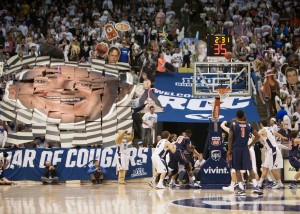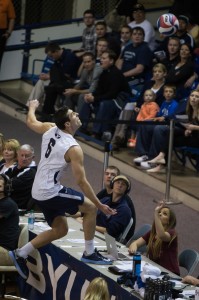BYU changed the student section dramatically two years ago, renaming it Roar of Cougars, or ROC, to give non-athlete students a different – and hopefully more competitive – impact on the game.

BYU’s athletic marketing department overhauled the All-Sport Pass almost two years ago, renaming it the ROC Pass and unifying the student section at LaVell Edwards Stadium. The rebranding organized BYU’s student fan base at games to bring the section up to par with top athletic schools.
David Almodova, BYU’s assistant athletic director for marketing, had spent five years as Duke’s director of basketball marketing before joining BYU in 2007. Bleacher Report named Duke’s “Cameron Crazies” the second-best student section in NCAA basketball in 2014.
“We wanted to be unified, but it was hard, because the students were scattered throughout the football stadium,” Almodova said. “And we needed a name. BYU didn’t have anything at that point.”
The team spent a year developing the new brand but didn’t alter the pricing system. The ROC Pass still uses a flat admission rate for the majority of campus sports, including football and basketball, while offering another cheaper option without football.
“We want it to be affordable, and if you break it down, it’s not that expensive,” Almodova said. “Other schools are charging $200 to $300 just for football.”
Universities nationwide use a variety of ticketing systems for their students. The University of Oregon charged students $367 for football season tickets in 2014, but only 1,000 were available. Other Oregon students tried to get tickets game by game in a lottery. The University of Alabama lets continuing students buy football season tickets, but freshmen can only buy partial-season packages. The University of Wisconsin sells separate season tickets for basketball and football, and almost all other sports are free. UCLA ($129), Texas A&M ($290) and Kansas University ($175) use all-sports passes similar to BYU.
Marketing Coordinator Kevin Kindred said ROC Passes for the 2015–2016 seasons will be $125. The price has increased $10 since its creation in 2013.

For students questioning whether the ROC Pass is a worthwhile investment, the cost can be broken down by sport and seats. A student attending only football and sitting within the first 65 rows would have to attend 4.2 games on average to justify buying the pass. A student attending only basketball and sitting in any of the non-bleacher areas of the ROC would have to attend 5.5 games to offset the cost. However, if a student plans to sit in the upper bleacher area of the Marriott Center or LaVell Edwards Stadium for every game, the ROC pass is more expensive than season tickets.
Generally, any combination of attendance that includes five total basketball or football games validates a ROC Pass purchase, even before including other sports like volleyball, gymnastics, softball and baseball.
ROC Passes can remain cost efficient because of businesses that sponsor it. Mountain America Credit Union is one of the primary ROC partners. The credit union offers a combined ROC Pass and debit card and will deposit $75 when a student opens the account. Bam Bam’s BBQ hosts watch parties for away games and caters select ROC events.
“Sponsorship wasn’t a driving force (in the ROC’s development),” said Casey Stauffer, general manager of BYU IMG Sports Marketing. “It is more of a natural supplement to creating an organized student section. … As the ROC continues to grow and be an active part of athletic events, sponsorship will increase to accommodate them.”
Athletic administration handles the business side of the ROC, but the student-run ROC board works to strengthen students’ game-day presence. The board consists of 30–40 student volunteers who aim to hype BYU athletics, increase student attendance and unify the ROC in cheers that support the Cougars and distract opponents. The board organizes pre-game ROC parties and chants for an intimidating atmosphere that gives BYU a better home-court advantage.
Board president Chad Burton is a graduating senior who’s been involved in ROC leadership for two years. “We’re constantly testing new things,” Burton said. “I try to implement about 50 new ideas every week, but only about two of them take.”
Chad said other schools’ student sections have iconic traditions, but BYU hasn’t quite found its own yet. “As soon as you show up on campus, you’re part of the ROC,” Burton said. “We want everyone to get involved and know they’re part of this.”




